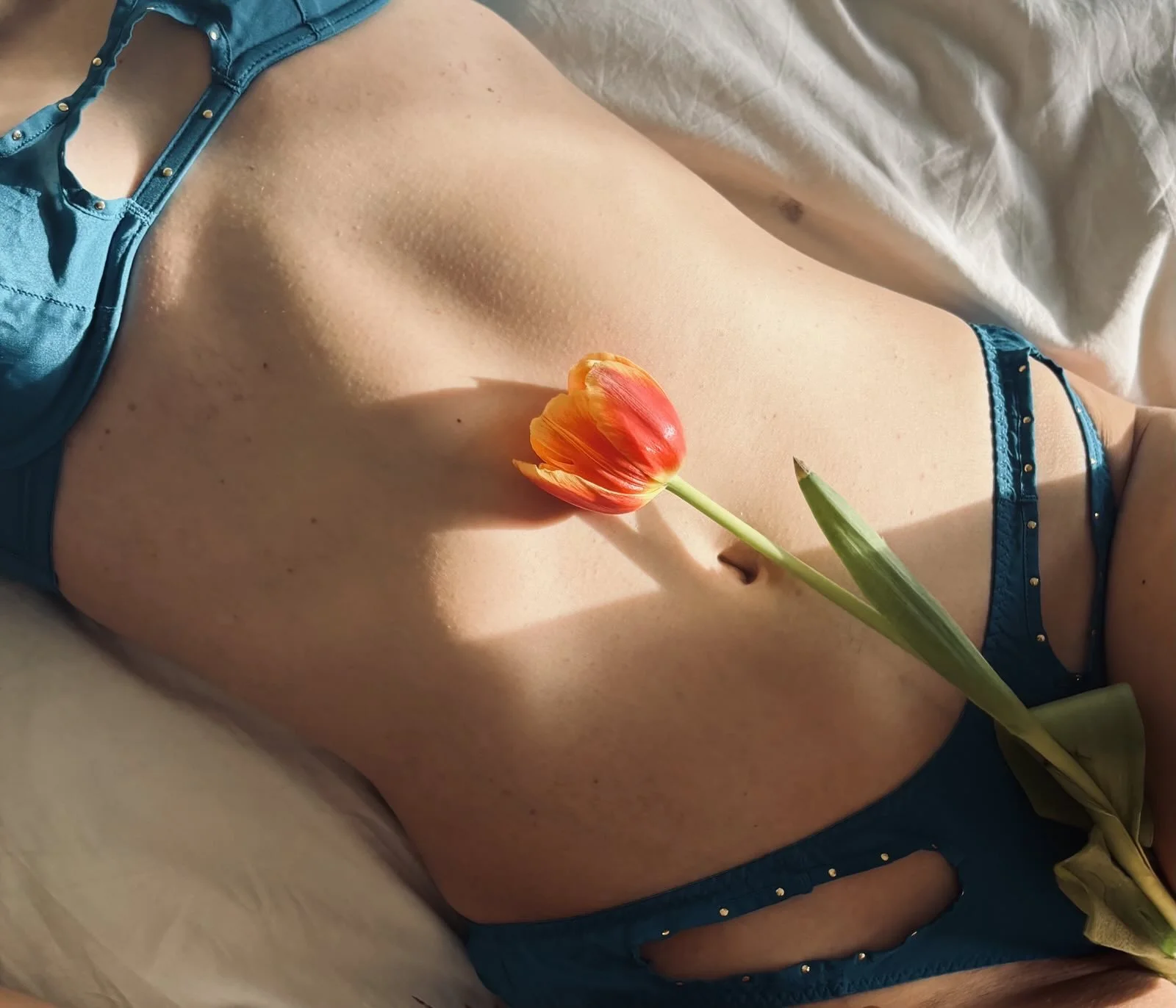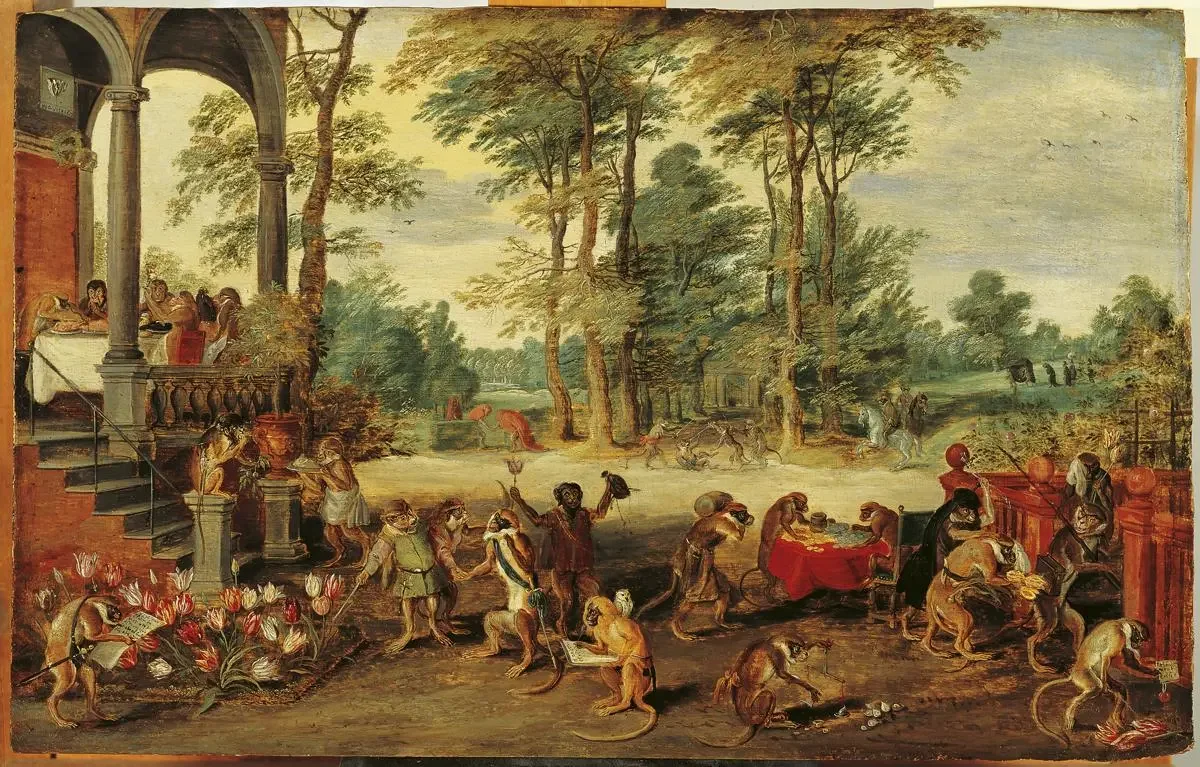I think, therefore I Amsterdam: Tulip Fever
Series in which I offer a new take on an old Dutch classic, part 1.
Charlie with innocently positioned tulip
Songs possess an uncanny power over us. They can sway hearts, lovers, and, on occasion, entire peoples. When it comes to the Dutch, one song in particular has the ability to move virtually any denizen of the land of cheese and windmills (those who claim otherwise are, objectively, not to be trusted): Tulips from Amsterdam. The sing-along star of any happening, it sets the mood of a postcard-perfect scene, with lyrics celebrating tulips, spring, love – and the Dutch tendency to show, not tell, as expressed in the final line: what my lips can’t express, tulips from Amsterdam will say.
The song is at once complete kitsch and significant cultural heritage: playful, sentimental, and deeply rooted in the collective imagination. Whenever I hear it, something stirs. I find myself singing along, hips swaying, tapping into some strange archive of memories that I experience, temporarily, as my own. And – most importantly for the subject matter at hand – it played a significant role in forging the city’s international identity and its now-inextricable link with, you guessed it: tulips.
But did you know that this song originated not as a Dutch song, but as a German Schlager tune? A singer who had just visited the tulip fields at the famous Keukenhof felt, well, inspired. Only a few years later was it adapted into Dutch, and set to a melody loosely inspired by a Tchaikovsky’s ‘Flower Waltz’ from The Nutcracker. And let’s be honest, who doesn’t love a good waltz? The song, however, is not the only thing that didn’t actually originate in the Netherlands – for neither did the tulips.
Postcards from the Ottoman Empire
The tulip does call the mountainous regions of Central Asia (modern-day Kazakhstan and surrounding areas) its home, where it was cultivated by the Ottoman Empire in what’s now Turkey. Even the name tulip isn’t Dutch, and probably comes from the Persian word dulband (turban), because the flower’s shape reminded people of the cloth’s winding. Physical bulbs arrived in the Netherlands in the late 16th century via trade routes and botanical collections, and the flowers did feel immediately at home in the Dutch climate (as opposed to yours truly) and soil. But tulips from Amsterdam? Not exactly.
But that didn’t stop them from becoming an instant status symbol back in the day, or from being virtually omnipresent today: bouquets of tulips, tulip-inspired souvenirs, and bags full of tulip bulbs are sold on every corner of the city of Amsterdam. And the nearby tourist favorite, Keukenhof, is not just popular with the Germans: it attracts a whopping 1.4 million visitors annually from all over the world.
Before I suggest some other, less overwhelming ways to get acquainted with Amsterdam’s floral symbol, let me catch you up on some more historical intrigue:
The Bulb that Burst
Painting ‘Allegory on Tulipmania’ by Jan Brueghel the Younger 1640
In contrast to the tulip, modern-day capitalism does have its roots in Dutch land. In the early 1600s, when tulip bulbs were first brought to Dutch soil, the Netherlands was a global trade powerhouse through the Dutch East India Company, also the first publicly traded corporation. This era marked the advent of stock trading: people would invest, for the first time in history, in small parts of actual trading ships. This coincided with a growing middle class, many of whom had disposable income, and an unprecedented hunger for luxury goods, which had until then only been available to the very few. As the first “ordinary people” gained access to speculative markets, tulips became a perfect object of utter desire: exotic and rare, limited in supply, visually striking, seasonal, and conveniently pocket-sized.
Tulip mania, or tulip fever, enters the scene.
And we all know fever is, well, quite infectious. Everyone caught the tulip bug, enthralled by this new object of maddening desire.
At first, tulips were traded in small circles among botanists and collectors, but then the so-called windhandel (“trading in air”) emerged: contracts to buy tulips at a future date before the bulbs had even been lifted from the ground. That is, people paid down payments for the right to purchase bulbs in spring at an agreed price – essentially the emergence of a futures market. And these contracts began to change hands multiple times before a single bulb ever bloomed, inflating prices without any physical tulips being exchanged. Historians later declared this the first ever recorded speculative bubble in market history. A grand, floral bubble – and very Dutch.
To illustrate: at one point, the rare Semper Augustus could fetch a price comparable to an actual canal house in the city center. There’s even a documented case where a single bulb sold for the equivalent of twelve acres of land.
Of course, when the whole thing collapsed in early 1637 – after buyers failed to show up at auctions in Haarlem – panic spread. But most of the financial damage was tied up in futures contracts rather than actual bulb deliveries, and many debts were never actually enforced. In Dutch there’s a saying which translates to: the soup is never eaten as hot as it is served, a reference to the idea that things are usually not quite as bad as they initially seem to be. This legal soft landing also meant that broader economic damage was contained, though a good number of reputations (and fortunes) were not.
The free market flower
Although the tulip did not originate in the Netherlands, it became deeply intertwined with the country’s capitalist history. Our country is often regarded as the first fully capitalist nation, preceding England, which later expanded the model through industrialization. The tulip, then, serves not as a symbol of national origin, but as an emblem of a new political economy: capitalism.
And it is through the tulip that we can grasp some of the distinct developments at the time which still signify late capitalism today. Stay with me:
As an exemplary instance of the commodification of beauty, she seduced the Dutch with her vibrant colors and interesting patterns.
She then set in motion a trend of the financialization of goods, as futures contracts suddenly turned a flower into an abstract financial instrument.
Moreover, the focus shifted from planting tulips to flipping contracts, inaugurating the phenomenon of speculation detached from use.
Never before did the nouveau riche merchant class test the boundaries of wealth creation outside of physical trade to this extent – a distinct feature of the capitalist risk-reward appetite we’ve come to know so well.
And, lastly, her price came to be driven by collective belief instead of intrinsic value, introducing to the scene a whole new kind of market psychology and a matching consumer subjectivity. In the 388 years since the tulip bubble burst, we've learned a great deal about how people behave when the promise of profit is high. What we arguably haven’t quite mastered, however, is controlling our own behavior.
Seeking: Floral Arrangement: Tulip-inspired dates
Hans Bollingier – Stilleven met Bloemen, Rijksmuseum
Knowing about the tulip’s history – from its transnational beginnings in the Ottoman Empire to becoming the object of the world’s first speculative bubble in 17th-century Holland – might just transform them from ‘pretty flowers’ into cultural artefacts. So, the next time you see a tulip, may you no longer look simply at some petals, but instead be reminded of a centuries-old story of ambition, desire, risk, and the business of beauty.
And why not stage ourselves in the long arc of history and indulge a little while we’re at it? Instead of only visiting the tulip fields of the Keukenhof, which tend to get very crowded, I have some ideas on making your quest for tulips more intimate and bespoke. Below, I’ve gathered some suggestions for very effective and enjoyable ways to catch the fever. Together, of course.
Hortus Botanicus
Founded in 1638, the Hortus Botanicus is one of the world’s oldest botanical gardens, and one of my favorite places to go in the city, bring a book, and spend an afternoon. Originally established as a medicinal herb garden, it today houses a curated collection of historical plant species, including heirloom tulip varieties that hark back to the early Dutch fascination with the flower. Though not large in scale, its tulip collection offers something subtler, I’d say, staging tulips as living history rather than mass spectacle.
Museum Van Loon
Located in a stately 17th-century canal house, the museum was once home to a co-founder of the Dutch East India Company. Each spring, its formal garden is replanted in historical style with seasonal bulbs, including tulips. The setting evokes a Golden Age tableau, with the flowers carefully integrated into a vision of wealth, order, and colonialism.
Rijksmuseum
Although no tulips bloom here, the Rijksmuseum offers another kind of floral immersion: still lifes from the Dutch Golden Age, many featuring the highly prized tulip. Paintings by artists such as Ambrosius Bosschaert and Jan Davidsz. de Heem show tulips in impossible arrangements: blooms from different seasons placed together as a painterly fantasy of wealth, beauty, and mortality. It’s the flower as vanitas, and as social commentary.
Waldorf Astoria
Inspired by master painter Vermeer, this canal-side hotel (the mayor of Amsterdam lives on the same street, by the way) features a courtyard garden planted with 5,000 ‘American’ tulips by Saskia Albrecht. American tulips are not native to America but often developed or named for the American market (with popular kinds carrying names such as ‘American Dream,’ ‘Purple Crystal,’ ‘One Direction,’ and ‘Foxy Foxtrot’). These are Darwin Hybrids, bred for height, durability, and large, showy colors. The ‘American Tulips’ aren’t an homage to tulip’s origins, but rather a nod to modern horticultural artistry. And their suites are perfect if you enjoy the old, ornamental, and typical Amsterdam canal vibes.
Conservatorium – In Bloom Package
The Conservatorium offers a tulip-themed experience that includes bespoke floral arrangements in-room, priority access to select gardens and events, and seasonal dining reflecting the spring mood. It’s not about quantity, but quality here, and carefully curated details that let you inhabit the floral moment without the crowd. I’ve never booked it before, but the hotel is one of my favourite hotels in the city and I’d love it if you’d book this for us.
Anantara Grand Hotel Krasnapolsky
Last but not least: situated on Dam Square, this historic hotel boasts its very own tulip cultivar: the Krasnapolsky Tulip. A striking red flower with pale edges, it was developed specifically for the hotel as a symbol of its rootedness in Amsterdam’s cultural life. A modern blend of pretty brilliant branding and botany. Let’s get our hands on some bulbs, shall we?




